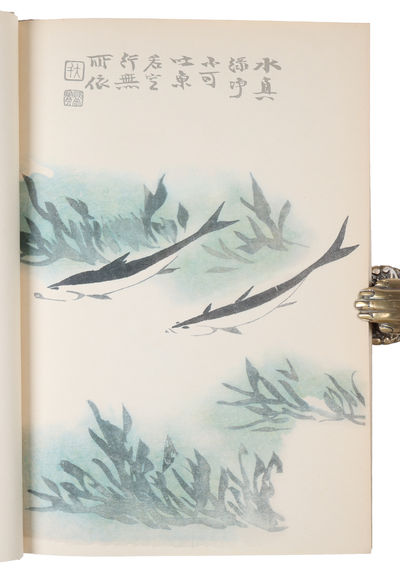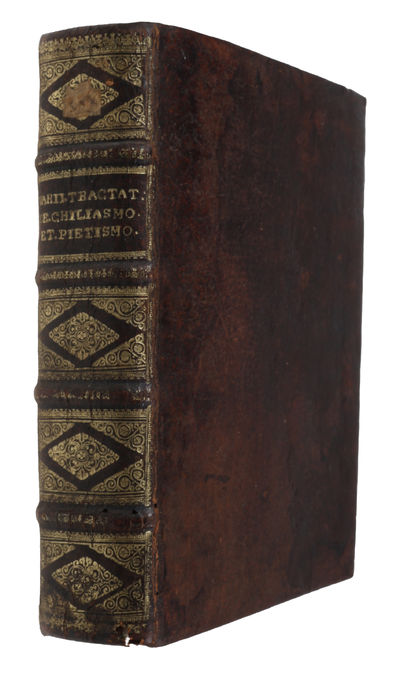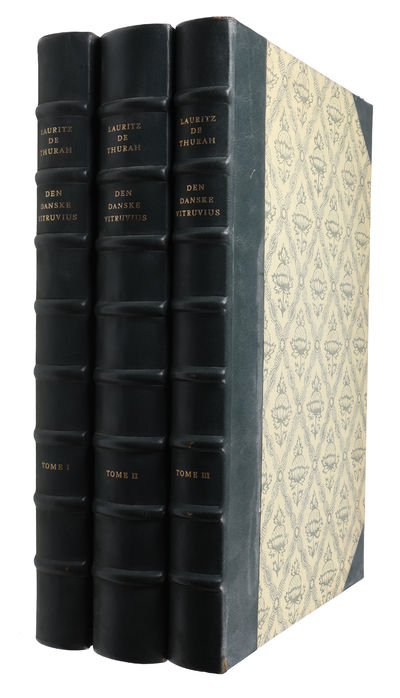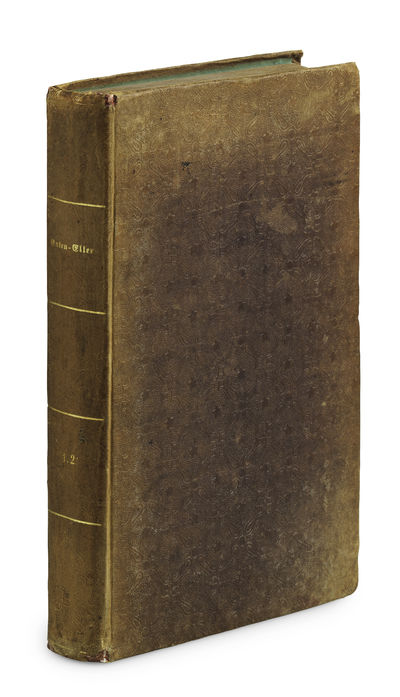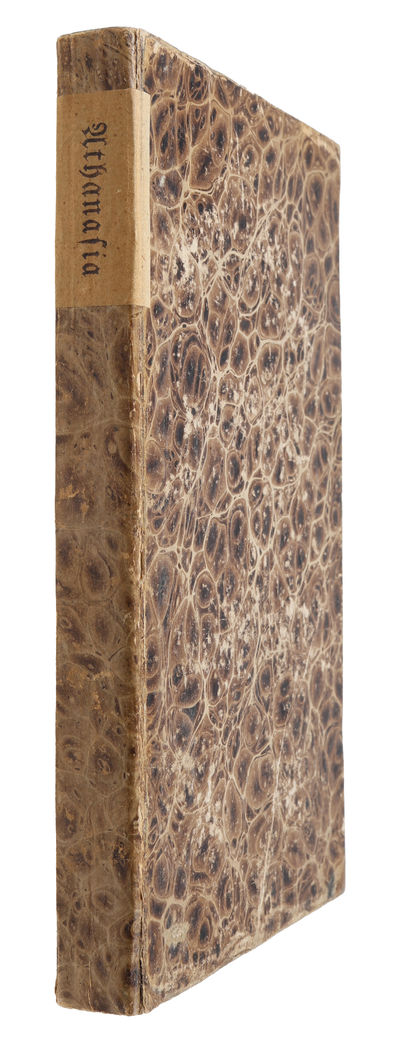FRACASTORIUS, HIERONYMUS [GIROLAMO FRACASTORO OF VERONA].
Syphilis, sive morbus gallicus. - [THE RAREST AND MOST IMPORTANT EDITION OF THE SYPHILIS-POEM]
Herman H. J. Lynge & Søn A/S
lyn39416
Roma, Apud Antonium Bladum Asulanum (on colophon), 1531, mense Septembri. 4to. Sown, uncut and unbound. Title-page and a few other leaves with a bit of minor brownspotting; overall a very nice and well-preserved copy of this beautifully printed, extremely scarce work. Two quires with loose leaves. Floriated large initial at beginning. [32] ff. (being title-page, 29 ff. text, 1 f. errata, 1 f. blank).
The exceedingly scarce second edition (the "Rome text") of "[t]he most famous of all medical poems" (Garrison & Morton), the poem which gave to the disease syphilis its name, being the most important edition of the work, the first complete edition (with the two lines of the first book printed for the first time - not found in any other contemporary editions of the work), the only authoritative version of the text to appear contemporarily, and by far the rarest edition - with only four known copies at the time of the official bibliography (Baumgartner and Fulton, 1935) (whereas the first edition from the year before, 1530, was known in 30 copies) - our copy also with the final blank leaf (H4), "not preserved in any copy examined" (Baumgartner & Fulton, p. 38)."The edition published at Rome (no. 2) in the following year is a finer piece of printing, AND IT IS EVIDENTLY A MUCH RARER WORK SINCE ONLY FOUR COPIES HAVE BEEN TRACED, WHILE AT LEAST 30 COPIES OF THE VERONA EDITION (i.e. the first edition) ARE KNOWN." (Baumgartner & Fulton, p. 37). Apart from the work itself being of the greatest impact on the history of medicine, giving to Syphilis its name and epitomizing contemporary knowledge of the illness, and the author being one of the most renowned physicians of the Renaissance, being compared in scope and excellence to Leonardo da Vinci, the present work in the present second edition has yet another feature, apart from its utmost scarcity, which contributes to its excellence; it is printed by the excellent Italian printer Antonio Blado, whose works are scarce and very sought after."Textually, as well as typographically, this is the most important edition of Fracastoro's poem, since, unlike those which follow, it bears evidence of having been supervised by Fracastoro himself, the two lines which had been omitted from Bk. I of the Verona edition being here included (verses 1 and 2 on leaf C2b) in exactly the form in which they were written on the vellum copy of the 1530 edition mentioned above (see end of note)... Among his other achievements in typography Antonio Blado can claim the distinction of having issued the most beautiful edition of Fracastoro's poem of any of the sixteenth century. The format is larger than that of the Verona edition and the fount of large italic type seems particularly well suited to Fracastoro's even lined verses. As with the other editions of this period the capitals are in Roman throughout; the ornamental capital (Q) at the beginning of Bk. I is particularly well executed. Bks II and II have spaces at the beginning for an illuminated initial.THE BOOKS OF ANTONIO BLADO ARE APPARENTLY AS RARE AS THEY ARE EXCELLENT, AND THEY HAVE LONG BEEN SOUGHT AFTER BY ITALIAN COLLECTORS. Blado was born in 1490 at Asloa in northern Italy. In 1515 Blado settled in Rome where he remained until his death in 1567. He was a bold and original printer, who, as Fumagelli points out, almost invariably undertook new things, never reprinting classics, and only occasionally , as in the case of Fracastoro's poem, reprinting the work of a contemporary. In 1532 he issued the first edition of Machiavelli's "Il Principe", and in 1549 he became official printer to the Papal See..." (Baumgartner & Fulton, p. 39)."Girolamo Fracastoro (1484-1553), a Veronese of thick-set, hirsute appearance and jovial mien, who practiced in the Lago di Garda region, was at once a physician, poet, physicist, geologist, astronomer, and pathologist, and shares with Leonardo da Vinci the honour of being the first geologist to see fossil remains in the true light (1530). He was also the first scientist to refer to the magnetic poles of the earth (1543). His medical fame rests upon that most celebrated of medical poems, "Syphilis sive Moribus Gallicus (Venice, 1530), which sums up the contemporary dietetic and therapeutic knowledge of the time, recognizes a venereal cause, and gave the disease its present name..." (Garrison, History of Medicine, p. 233).The magnificent medical poem is about the main character, a young shepherd called "Syphilis", who induces the people to forsake the Sun God, who in return bestows upon man a new, horrible plague, which Fracastoro names after the shepherd. "It epitomized contemporary knowledge of syphilis, gave to it its present name, and recognized a venereal cause. Fracastorius refers to mercury as a remedy." (Garrison and Morton).The work must be described as seminal, and its great influence and importance has continued throughout centuries. As stated in the bibliography by Baumgartner and Fulton, which is devoted exclusively to the poem, "[t]he full extent of the influence exerted by a work which has received such wide recognition cannot be adequately estimated without searching bibliographical analysis", and thus they have traced 100 editions of Fracastoro's Syphilis-poem, including translations into six languages. 18 of these appeared in the 16th century, but it is curious to see, how the work continues to resurface up until the 20th century. Almost 200 years after the work originally appeared, Italy witnessed a great revival of Fracastoro and his poem, and the first Italian translation appeared in 1731, with a preface by the great Enlightenment philosopher Giambattista Vico, and by 1739 five Italian editions had appeared. Another revival of the work took place as late as the 20th century, with four new English translations appearing between 1928 and 1935."Le poème de Fracastor sur la Syphilis restera toujours un chef-d'oeuvre, parce que le pinceau est large, l'imagination hardie, la versification harmonieuse, et que le poète agrandit son sujet ingrat en remontant aux cases celestas, en montant la main des Dieux s'appersantissant pour punir la terre; la fiction, surtout, qu'il a imagine pour retrace la découverte du mercure, est un tableau digne des plus grands maîtres." (Achille Chéreau, Le Parnasse medical francais, 1874, p. xv). Baumgartner & Fulton, A Bibliography of the Poem of Syphilis sive Moribus Gallicus by Girolamo Fracastoro of Verona: no. 2 (our copy follows exactly the collation given here - and also has the final blank leaf mentioned but not found in any of the examined copies).Garrison and Morton: 2364. "There is every reason to believe that the first edition of 1530 was personally supervised by Fracastoro as it was passing through the press. The printer, however, omitted two verses in the first book, which have been inserted in manuscript, apparently by Fracastoro himself, in the copy on vellum now preserved in the Bibliothèque Nationale. As these two lines are included in the Rome edition of the following year, it is likely that Fracastoro also supervised this, the second edition, and that this should be regarded as the authoritative text, since there is no evidence of textual changes in seven subsequent editions during his life."
The exceedingly scarce second edition (the "Rome text") of "[t]he most famous of all medical poems" (Garrison & Morton), the poem which gave to the disease syphilis its name, being the most important edition of the work, the first complete edition (with the two lines of the first book printed for the first time - not found in any other contemporary editions of the work), the only authoritative version of the text to appear contemporarily, and by far the rarest edition - with only four known copies at the time of the official bibliography (Baumgartner and Fulton, 1935) (whereas the first edition from the year before, 1530, was known in 30 copies) - our copy also with the final blank leaf (H4), "not preserved in any copy examined" (Baumgartner & Fulton, p. 38)."The edition published at Rome (no. 2) in the following year is a finer piece of printing, AND IT IS EVIDENTLY A MUCH RARER WORK SINCE ONLY FOUR COPIES HAVE BEEN TRACED, WHILE AT LEAST 30 COPIES OF THE VERONA EDITION (i.e. the first edition) ARE KNOWN." (Baumgartner & Fulton, p. 37). Apart from the work itself being of the greatest impact on the history of medicine, giving to Syphilis its name and epitomizing contemporary knowledge of the illness, and the author being one of the most renowned physicians of the Renaissance, being compared in scope and excellence to Leonardo da Vinci, the present work in the present second edition has yet another feature, apart from its utmost scarcity, which contributes to its excellence; it is printed by the excellent Italian printer Antonio Blado, whose works are scarce and very sought after."Textually, as well as typographically, this is the most important edition of Fracastoro's poem, since, unlike those which follow, it bears evidence of having been supervised by Fracastoro himself, the two lines which had been omitted from Bk. I of the Verona edition being here included (verses 1 and 2 on leaf C2b) in exactly the form in which they were written on the vellum copy of the 1530 edition mentioned above (see end of note)... Among his other achievements in typography Antonio Blado can claim the distinction of having issued the most beautiful edition of Fracastoro's poem of any of the sixteenth century. The format is larger than that of the Verona edition and the fount of large italic type seems particularly well suited to Fracastoro's even lined verses. As with the other editions of this period the capitals are in Roman throughout; the ornamental capital (Q) at the beginning of Bk. I is particularly well executed. Bks II and II have spaces at the beginning for an illuminated initial.THE BOOKS OF ANTONIO BLADO ARE APPARENTLY AS RARE AS THEY ARE EXCELLENT, AND THEY HAVE LONG BEEN SOUGHT AFTER BY ITALIAN COLLECTORS. Blado was born in 1490 at Asloa in northern Italy. In 1515 Blado settled in Rome where he remained until his death in 1567. He was a bold and original printer, who, as Fumagelli points out, almost invariably undertook new things, never reprinting classics, and only occasionally , as in the case of Fracastoro's poem, reprinting the work of a contemporary. In 1532 he issued the first edition of Machiavelli's "Il Principe", and in 1549 he became official printer to the Papal See..." (Baumgartner & Fulton, p. 39)."Girolamo Fracastoro (1484-1553), a Veronese of thick-set, hirsute appearance and jovial mien, who practiced in the Lago di Garda region, was at once a physician, poet, physicist, geologist, astronomer, and pathologist, and shares with Leonardo da Vinci the honour of being the first geologist to see fossil remains in the true light (1530). He was also the first scientist to refer to the magnetic poles of the earth (1543). His medical fame rests upon that most celebrated of medical poems, "Syphilis sive Moribus Gallicus (Venice, 1530), which sums up the contemporary dietetic and therapeutic knowledge of the time, recognizes a venereal cause, and gave the disease its present name..." (Garrison, History of Medicine, p. 233).The magnificent medical poem is about the main character, a young shepherd called "Syphilis", who induces the people to forsake the Sun God, who in return bestows upon man a new, horrible plague, which Fracastoro names after the shepherd. "It epitomized contemporary knowledge of syphilis, gave to it its present name, and recognized a venereal cause. Fracastorius refers to mercury as a remedy." (Garrison and Morton).The work must be described as seminal, and its great influence and importance has continued throughout centuries. As stated in the bibliography by Baumgartner and Fulton, which is devoted exclusively to the poem, "[t]he full extent of the influence exerted by a work which has received such wide recognition cannot be adequately estimated without searching bibliographical analysis", and thus they have traced 100 editions of Fracastoro's Syphilis-poem, including translations into six languages. 18 of these appeared in the 16th century, but it is curious to see, how the work continues to resurface up until the 20th century. Almost 200 years after the work originally appeared, Italy witnessed a great revival of Fracastoro and his poem, and the first Italian translation appeared in 1731, with a preface by the great Enlightenment philosopher Giambattista Vico, and by 1739 five Italian editions had appeared. Another revival of the work took place as late as the 20th century, with four new English translations appearing between 1928 and 1935."Le poème de Fracastor sur la Syphilis restera toujours un chef-d'oeuvre, parce que le pinceau est large, l'imagination hardie, la versification harmonieuse, et que le poète agrandit son sujet ingrat en remontant aux cases celestas, en montant la main des Dieux s'appersantissant pour punir la terre; la fiction, surtout, qu'il a imagine pour retrace la découverte du mercure, est un tableau digne des plus grands maîtres." (Achille Chéreau, Le Parnasse medical francais, 1874, p. xv). Baumgartner & Fulton, A Bibliography of the Poem of Syphilis sive Moribus Gallicus by Girolamo Fracastoro of Verona: no. 2 (our copy follows exactly the collation given here - and also has the final blank leaf mentioned but not found in any of the examined copies).Garrison and Morton: 2364. "There is every reason to believe that the first edition of 1530 was personally supervised by Fracastoro as it was passing through the press. The printer, however, omitted two verses in the first book, which have been inserted in manuscript, apparently by Fracastoro himself, in the copy on vellum now preserved in the Bibliothèque Nationale. As these two lines are included in the Rome edition of the following year, it is likely that Fracastoro also supervised this, the second edition, and that this should be regarded as the authoritative text, since there is no evidence of textual changes in seven subsequent editions during his life."
Address:
Silkegade 11
DK-1113 Copenhagen Denmark
Phone:
CVR/VAT:
DK 16 89 50 16
Email:
Web:
![Syphilis, sive morbus gallicus. - [THE RAREST AND MOST IMPORTANT EDITION OF THE SYPHILIS-POEM] (photo 1)](https://d3525k1ryd2155.cloudfront.net/h/932/994/1035994932.0.l.0.jpg)
![Syphilis, sive morbus gallicus. - [THE RAREST AND MOST IMPORTANT EDITION OF THE SYPHILIS-POEM] (photo 2)](https://d3525k1ryd2155.cloudfront.net/h/932/994/1035994932.1.l.0.jpg)
